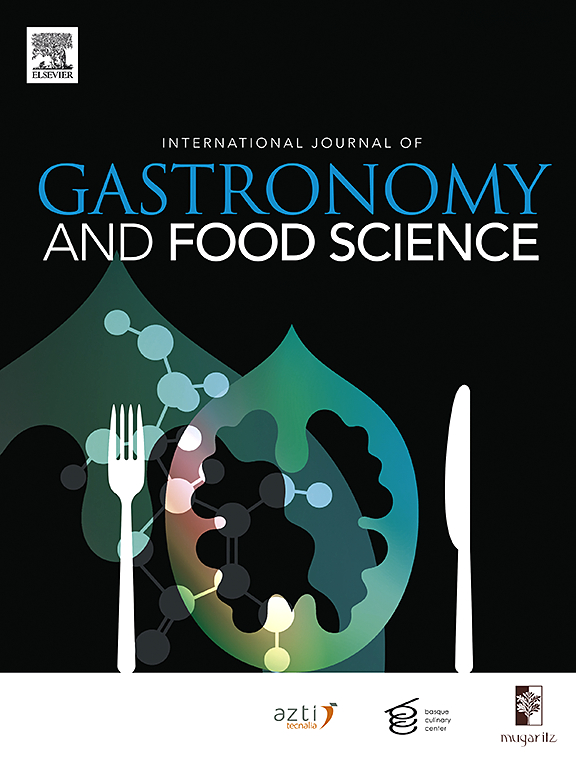香蕉芒果的加工:以感官质量和美食应用为重点,对蜜饯和开胃菜进行微生物评估和开发
IF 3.2
2区 农林科学
Q2 FOOD SCIENCE & TECHNOLOGY
International Journal of Gastronomy and Food Science
Pub Date : 2024-10-05
DOI:10.1016/j.ijgfs.2024.101028
引用次数: 0
摘要
香蕉花序被称为 "mangará",是香蕉种植中发现的非常规食用植物(NCEP)。尽管香蕉花序具有营养潜力,但由于其快速氧化和单宁酸会导致不愉快的感官特征,因此未得到充分利用。这项研究的目的是加工 mangará,以保持其微生物、物理和感官质量,供食品应用。首先,对莽格拉进行了物理特征描述和处理,以减少氧化和单宁味道。开发了三种蜜饯:水基蜜饯(WMP)、醋基蜜饯(VMP)和腌渍蜜饯(PMP)。这些蜜饯都经过了理化和微生物鉴定,并由美食专家进行了感官评估。WMP 还用于制作开胃菜(mangará caponata 和 relish antipasti),并进行了感官分析。PMP 显示出较高的可滴定酸度、可溶性固形物和蛋白质含量(2.76 毫克;4.0 ± 0.1 °Brix;0.45 ± 0.01%)。只有 VMP 和 PMP 符合 pH 值要求(低于 4.5)。所有配方的脂质含量都很低,微生物安全。微生物评估证实不含致病菌。比色分析表明,不同样品的 b∗ 值没有差异。观察到 VMP(10.01 μmol TE/mL)和 PMP(7.87 μmol TE/mL)具有相似的抗氧化活性。感官评估表明,所有样品都被接受,得分从 "略微喜欢 "到 "非常喜欢 "不等。Mangará caponata 是最受欢迎的开胃菜。这项研究证明了将芒果加工成微生物安全、感官愉悦的蜜饯和开胃菜的可行性,突出了其在创新烹饪用途方面的潜力。进一步的研究应探讨加工方法的可扩展性和保存的长期稳定性。本文章由计算机程序翻译,如有差异,请以英文原文为准。
Processing of banana mangará: Microbiological evaluation and development of preserves and appetizers with a focus on sensory qualities and gastronomic applications
Banana inflorescences, known as mangará, are non-conventional edible plants (NCEP) found in banana cultivation. Despite their nutritional potential, they are underutilized due to rapid oxidation and tannins, which cause unpleasant sensory characteristics. This research aimed to process mangará to maintain its microbiological, physical, and sensory quality for food applications. Initially, mangará was physically characterized and treated to reduce oxidation and tannin taste. Three types of preserves were developed: water-based (WMP), vinegar-based (VMP), and pickle-based (PMP). These preserves underwent physicochemical and microbiological characterization and sensory evaluation by gastronomy professionals. WMP was also used to prepare appetizers (mangará caponata and relish antipasti), subjected to sensory analysis. PMP showed higher titratable acidity, soluble solids, and protein content (2.76 mg; 4.0 ± 0.1 °Brix; 0.45 ± 0.01%). Only VMP and PMP met the pH requirement (below 4.5). All formulations had low lipid content and were microbiologically safe. Microbiological evaluations confirmed the absence of pathogenic bacteria. Colorimetric analysis showed no difference in the b∗ value between samples. Similar antioxidant activity was observed for VMP (10.01 μmol TE/mL) and PMP (7.87 μmol TE/mL). Sensory evaluation indicated that all samples were accepted, with scores ranging from “slightly liked” to “liked very much”. Mangará caponata was the most preferred appetizer. The study demonstrated the feasibility of processing mangará into microbiologically safe and sensory-pleasing preserves and appetizers, highlighting their potential for innovative culinary uses. Further research should explore processing methods' scalability and preserve long-term stability.
求助全文
通过发布文献求助,成功后即可免费获取论文全文。
去求助
来源期刊

International Journal of Gastronomy and Food Science
Social Sciences-Cultural Studies
CiteScore
5.30
自引率
10.50%
发文量
170
审稿时长
45 days
期刊介绍:
International Journal of Gastronomy and Food Science is a peer-reviewed journal that explicitly focuses on the interface of food science and gastronomy. Articles focusing only on food science will not be considered. This journal equally encourages both scientists and chefs to publish original scientific papers, review articles and original culinary works. We seek articles with clear evidence of this interaction. From a scientific perspective, this publication aims to become the home for research from the whole community of food science and gastronomy.
IJGFS explores all aspects related to the growing field of the interaction of gastronomy and food science, in areas such as food chemistry, food technology and culinary techniques, food microbiology, genetics, sensory science, neuroscience, psychology, culinary concepts, culinary trends, and gastronomic experience (all the elements that contribute to the appreciation and enjoyment of the meal. Also relevant is research on science-based educational programs in gastronomy, anthropology, gastronomic history and food sociology. All these areas of knowledge are crucial to gastronomy, as they contribute to a better understanding of this broad term and its practical implications for science and society.
 求助内容:
求助内容: 应助结果提醒方式:
应助结果提醒方式:


